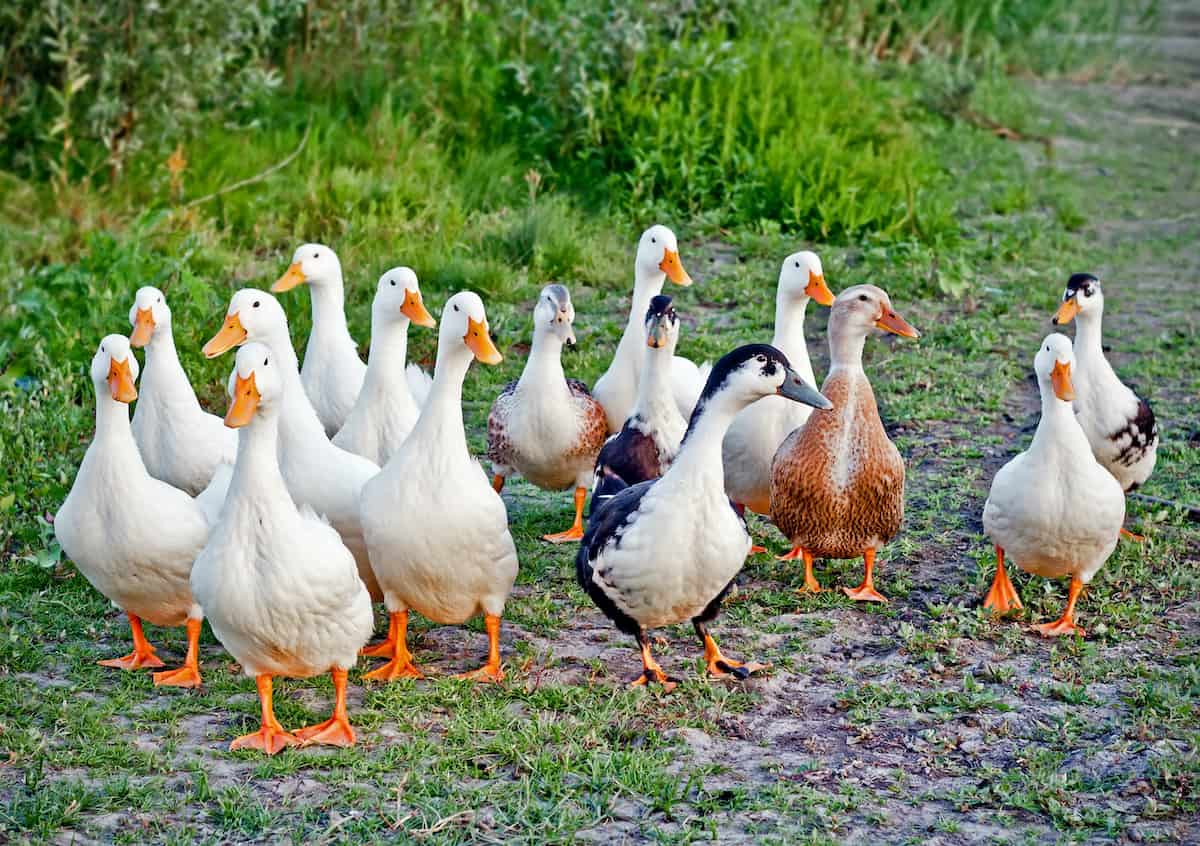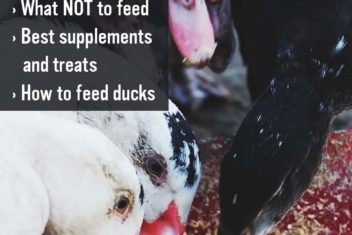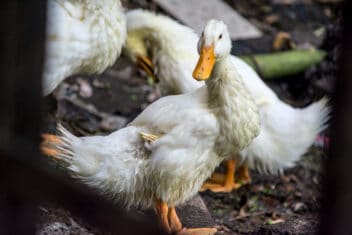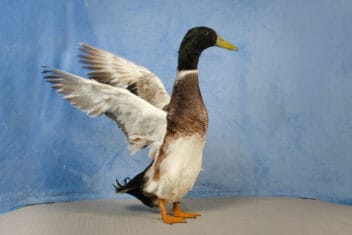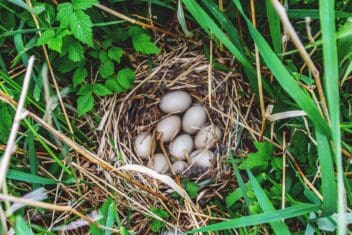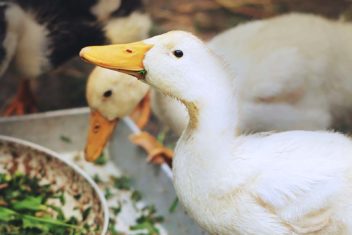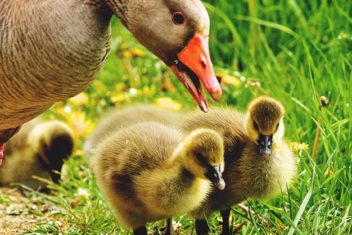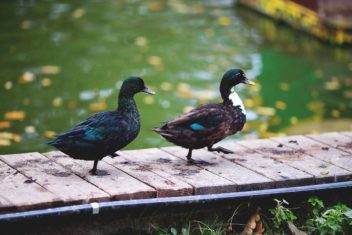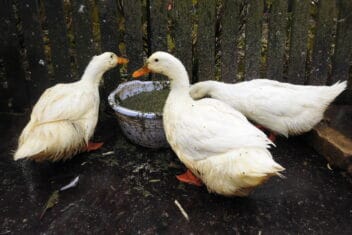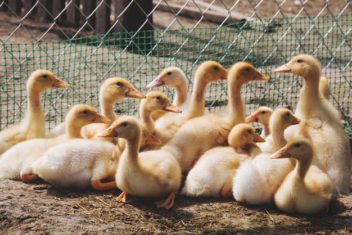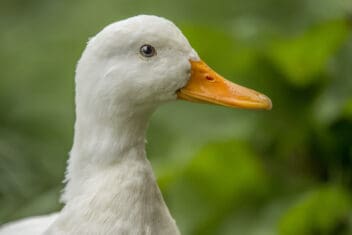Are you thinking about raising ducks for the first time or want to better understand how to care for and use the ducks you have? Well, then, you’ve arrived at the right place!
This is our ultimate guide to keeping ducks. It aggregates a wealth of information in one place to make your duck keeping journey easier.
In the sections that follow, you’ll find an overview of the various topics on raising and keeping ducks healthy and happy. Additionally, embedded links will take you to more comprehensive posts on many of these subjects so you can dabble deeper into the wonderful world of duck care.
Where appropriate, we’ll also give you a “quick start” recommendation to help beginners get your feet wet. These are simple solutions that will work for most duck keepers.
Just a word of warning… raising ducks is not as common or popular as raising chickens. So, you will have to use some ingenuity to do it well at home. Yet, I suspect if you are naturally drawn to ducks, then you likely fit the bill on what it takes to be a good duck keeper.
The Legality of Keeping Ducks
But first, before you get your heart set on keeping ducks, check with your local authorities to find out if ducks are legal to keep where you live.
Although ducks are really as easy to keep as chickens, not all town or city ordinances allow ducks. Also, many homeowner’s associations have rules that may rule out duck keeping.
Now, if you are ready to get started or grow your duck keeping skills, here we go!
Reasons for Keeping Ducks
Narrowing down your reasons for keeping ducks early on will make designing your duck care systems much easier. Here are the two main reasons people keep ducks and the ways these purposes will impact how you raise ducks.
Keeping Ducks for Meat Production
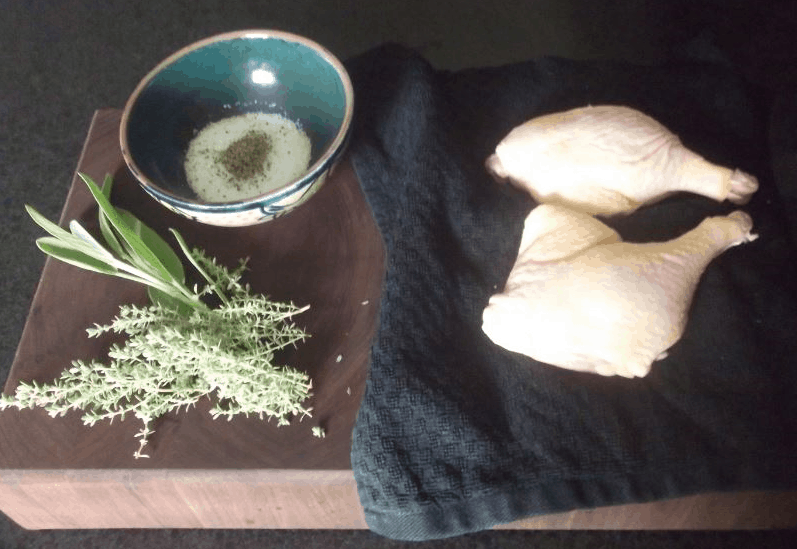
In the US, duck meat is mostly sold as a novelty or for making ethnic cuisine such as in French or Chinese cooking. However, in many other parts of the world, duck is considered an excellent choice for regular meat supply.
Here’s why.
1. Excellent Foragers
Ducks are excellent foragers, particularly in wetland areas. They are often used in conjunction with rice fields or other kinds of aquaculture. They are also very common in permaculture systems where they can often mostly feed themselves if given enough room to roam.
2. Easy to Herd
Ducks are easy to herd or lure to new locations. That makes it simple to move them to new pasture in a rotational pasture system.
Some people do this with work dogs or directional panels. Personally, I move ducks simply by filling a fresh kiddie pool and moving their food.
3. Disease Resistant
Ducks are also more disease resistant than other poultry, even in confinement. They don’t have the same risks for coccidiosis. They can generally be raised without any kind of medication.
4. Delicious Meat
The main reason though that duck is such a popular meat choice is because of the rich flavorful meat that eats like a great steak but is closer to chicken in terms of heart-healthiness.
Also, the renderable fat that sits on top of the muscles can be turned into tasty lard that’s preferred by chefs.
Downsides to Raising Ducks for Meat
There are a few downsides to raising ducks for meat.
1. Slower Production
Compared to broiler chickens, duck eggs take longer to hatch. Pekins take a few weeks longer to grow to mature size than broiler chickens. Other breeds can take months longer to mature than a broiler chicken.
Still, ducks are ready to process in much less time than larger animals like pigs, sheep, goats, or cattle.
2. Extra Feed Costs
In confinement, ducks also require a lot more feed than broilers which makes production costs higher. Or, if allowed to forage, ducks will take longer to fatten for processing, and unless forage is abundant, that may still lead to higher feeding costs.
3. Difficult to Process
Ducks are also hard to pluck because of their deeply embedded feathers and downy undercoats. Even with professional equipment, it can take 2-3 times as long to process a duck than a broiler chicken.
Keeping Ducks for Egg Production
Worldwide, egg production is second to meat production in reasons for raising ducks. In the US, however, lots of people raise ducks only for their incredibly rich, high mineral content eggs.
Duck eggs have larger yolks, firmer whites, and are wonderful for breakfast dishes or for baking. However, they are not so great for making things like mayonnaise or macaroons because they have a different viscosity than chicken eggs.
1. Laying Breeds
Female ducks are sometimes called hens, but usually, they are just called ducks. All healthy female ducks lay eggs, though some only lay during the breeding season. So, for peak egg production, you’ll want to choose year-round laying breeds.
2. Seasonal Egg Outage
Even breeds that lay nearly year-round will still have intermittent or temporary egg outages when day length is shortest. Though, for highly productive laying breeds, like hybrid layers, supplemental light can increase winter laying capacity.
3. Lifetime Production
Just keep in mind, ducks lay a limited number of eggs in their lifetime. Seasonal laying Muscovies make about 60-130 eggs a year (depending on whether they set a nest or not). They can also keep on laying that many eggs for 7-10 years.
However, hybrid layers that put out 320 eggs in their first year of laying, will see drastic reductions in egg capacity in subsequent years.
Choosing the Right Duck Breed
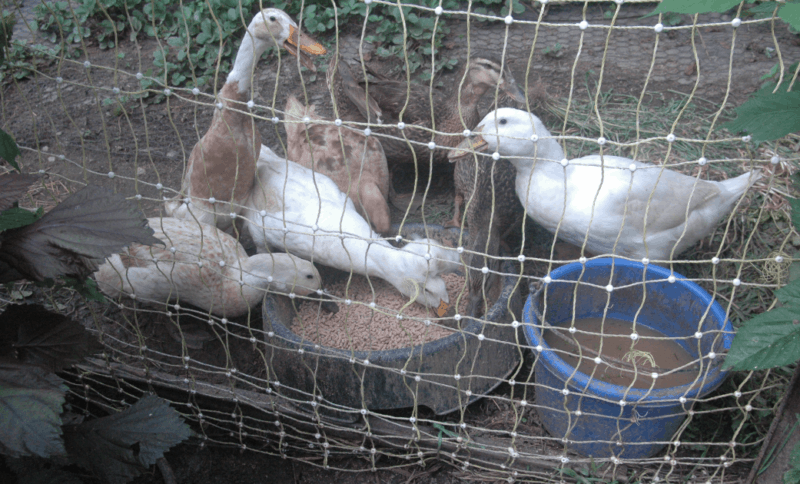
There aren’t nearly as many duck breeds as chicken breeds. Yet, choosing the right duck breed can still be a difficult decision that requires a lot of thought and research.
You need to consider whether your primary purpose for raising ducks is meat, eggs, or dual-purpose. You also need to consider your climate, the size of your shelter, and your available forage area.
Additionally, all ducks need access to water for drinking and grooming. However, some are natural born swimmers and others are land lovers who only need a little water to groom. So, you’ll want to match your duck breeds to how much water access you plan to provide.
Quick Start: Breed Selection
If you are looking for ducks that free-range well with supervision, and will also be content in spacious confinement, here are three homestead favorites.
1. Pekin Ducks

All that these large white beauties require for contentment are a freshly filled kiddie pool, a constant food supply, shade in summer, snow protection in winter, and safety from predators.
Pekins ducks work well as egg layers and as a meat breed. They also make great docile pets.
2. Khaki Campbells
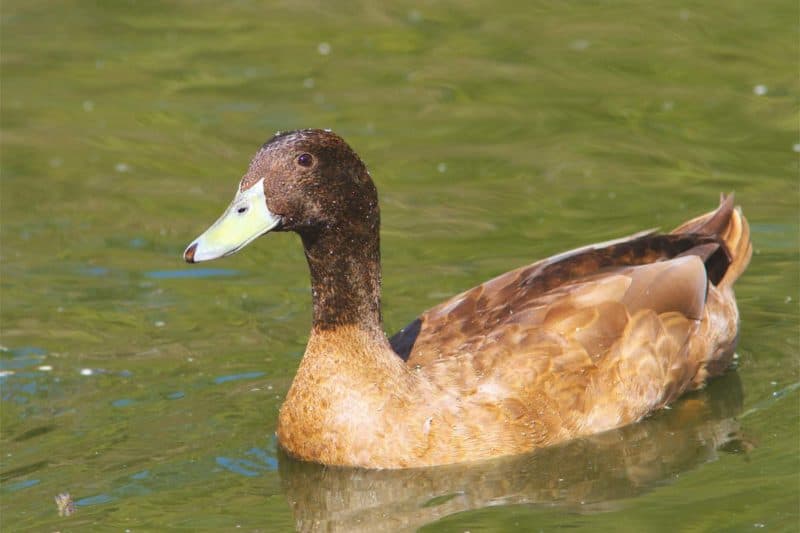
These lovely brown layers of lots of eggs are smaller than the Pekins and don’t require quite as much feed. However, they are just as easy to keep happy on the homestead.
Khaki Campbells still love water but can bathe in a bucket if access to water is an issue.
3. Indian Runner Ducks
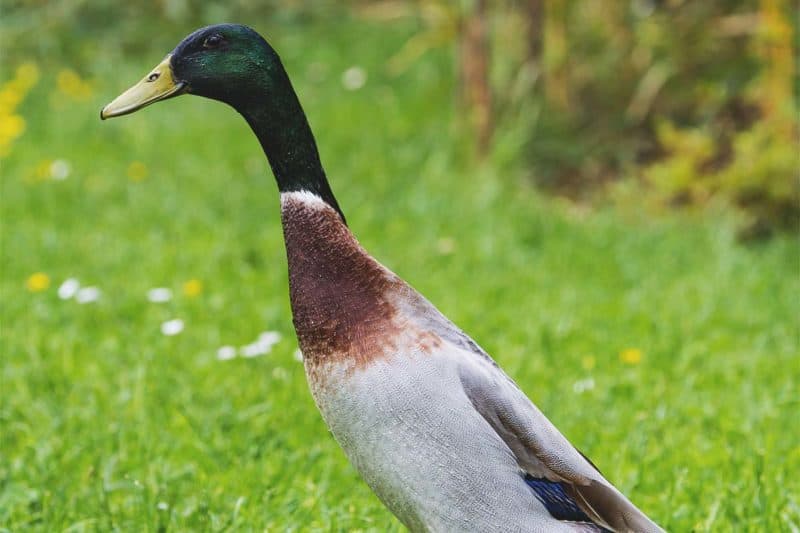
If you want ducks to run along the paths around your raised bed garden or under your edible landscape and eat slugs and snails, without damaging your plants, these are the perfect pick. Indian runner ducks are an upright, dry-land loving garden duck.
They are lightweight and require much less feed than larger breeds. Egg-laying capacity varies by lineage, so check with your breeder for details. Runners are better for warm climates or will need winter weather protection in cold areas.
These three duck breeds are easily adaptable to lots of different homestead types and will help you grow your appreciation of ducks as you gain skill.
Quick Tip: Meat Ducks
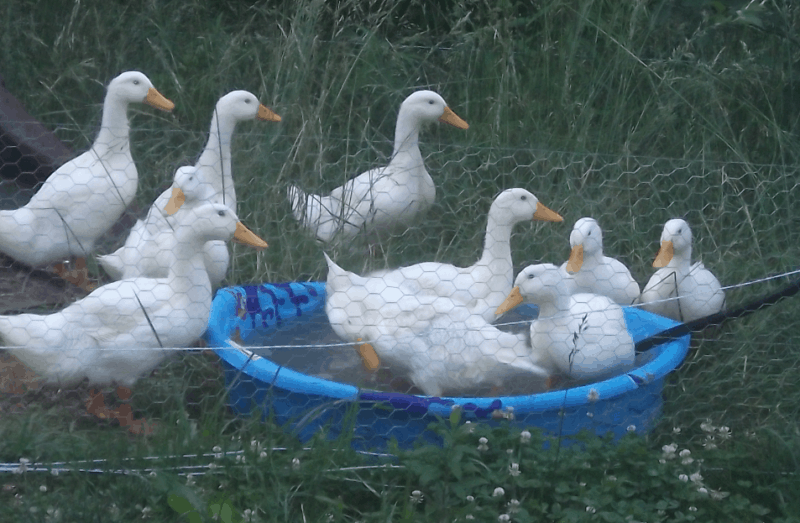
If you want to get started raising ducks for meat, the easiest way to do it is to order a batch of Jumbo Pekins. These are extra-large, fast-maturing meat ducks that will be ready to process in 8-10 weeks if confined and well-fed.
Processing ducks is similar to processing chickens. However, plan to spend extra time hand plucking duck feathers after scalding. Also, I have an easier time when I soak duck carcasses before scalding to get all the feathers wet and keep the temperature at 155°F.
Quick Tip: Egg-Laying Ducks
If you want occasional duck eggs over the long haul, choose a hardy seasonal layer. If you want peak egg production, choose a year-round production laying duck. Then plan to cull and replace when egg production declines.
Should You Keep Male Ducks?
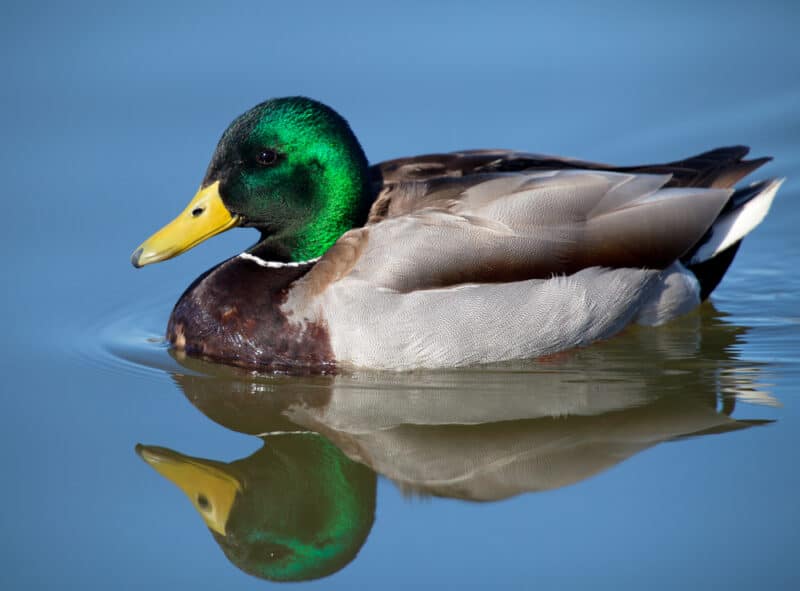
If your main reason for having ducks is eggs, and you don’t plan to hatch those eggs, then you only need female ducks. Egg production will be higher without the stress of mating.
Also, unlike chickens who sometimes benefit from having a rooster to sort out pecking order issues, female ducks live in near-perfect harmony without male leadership. So, unless you want to breed your own ducks, you can skip the drake.
Breeding
Now, if you want to breed your own ducks for meat or replacement layers, then you also need to know about duck sex. By that I mean, how to tell the sex of your ducks and also how to facilitate duck sex for reproduction.
1. Identifying Female Ducks
As females begin to mature sexually, they develop the ability to quack. They tend to be very noisy for several months after they find their voices. They generally become sexually mature and start laying between 5-8 months of age depending on the breed.
2. Ready to Breed
Egg production will start slowly for the first few weeks and eggs may be small in size. Once those eggs are uniform in size and are coming every single day in warm weather, then your duck is technically ready to breed.
At this point, you can expose your female to a male duck and collect those eggs to hatch. Female ducks can store sperm in their reproductive tract for 2-15 weeks. That means, your ducks don’t need to mate daily for eggs to be fertilized.
On homesteads, we often just let the male ducks, called drakes, stay with the females. However, if a drake is stressing your ducks, then you can separate them and only allow conjugal visits as needed for egg fertilization. Generally, to ensure fertilized eggs aim to breed your female every 10 days.
3. Drakes
Drakes typically become sexually mature a little before the females of the same breed do. This can cause some discord as the drakes try to mount unwilling females. However, it passes once the females also reach sexual maturity.
Sex Identification
There are several ways to tell male from female ducks. This is important to know if you buy straight run ducks or hatch your own.
1. Feather Sexing
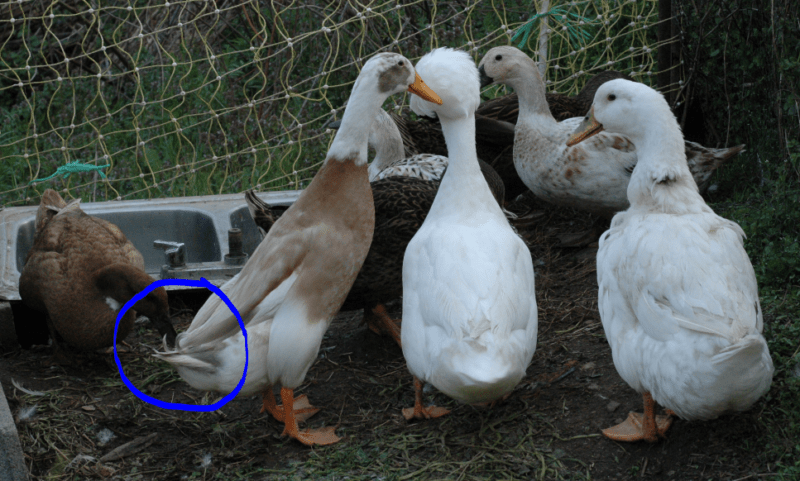
Some hatcheries have developed lines of ducks that can be sexed as ducklings by their feather colorations. Feather-sexable males tend to be darker or have black colors while females are lighter and have brown colors.
2. Bill Sexing
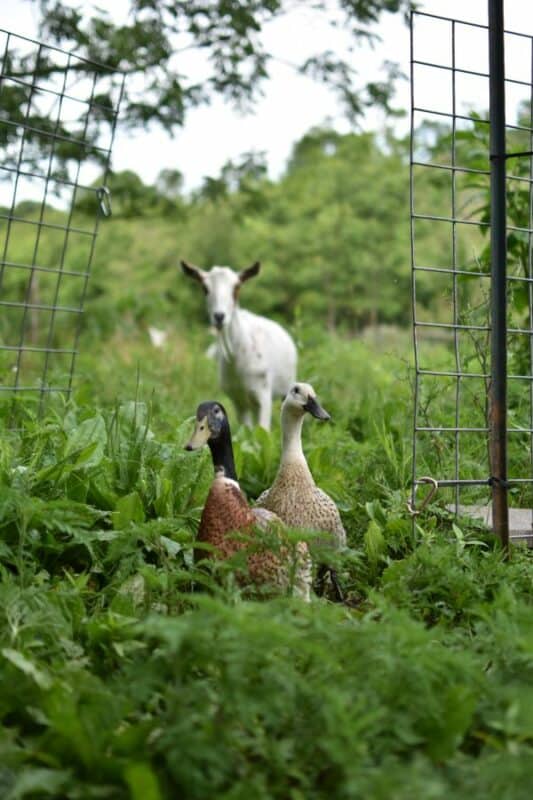
Additionally, some breeds like the Welsh Harlequin can be sexed at birth by the color of their bills. Males have darker bills initially. However, within a couple of days of hatching the female bill darkens. Later, the female bill darkens to black and the male bill turns green to orange.
3. Vent Sexing
For day-old ducklings, vent sexing is also used. Essentially the vent opening is carefully pushed back to reveal the sexual organs inside. Males will have the tiny start of a white curly penis, whereas females will not.
It takes some experience to be able to vent sex with accuracy. So, even hatcheries can’t guarantee the accuracy of vent sexing.
4. Drake Feathers
Young drakes are easy to identify because they develop one or more curled tail feathers when they become sexually mature. The first time they molt, those drake feathers are dropped and don’t grow back. So, older drakes don’t have drake feathers.
5. Mating Feathers
In many duck breeds, during the mating season males have more distinctive feather colors than females. The contour feathers, under the wings, and around the neck are often the easiest place to look to distinguish males from females. During fall and winter migration, though, males have drab-colored feathers and can be harder to distinguish from the females.
Pekin males and females are similar in size and color. You can still tell them apart though because the bills and feet of Pekin females become pale and develop dark spots when they start laying and continue to age. Pekin males, however, keep their bright orange feet and bills.
6. Lack of Quack
Drakes don’t quack. Male and female ducklings make those adorable but shrill, shrieking chirps and screams. However, males lose their voices and begin to make a husky whispering sound starting at around 10 weeks of age.
7. Muscovy Exception
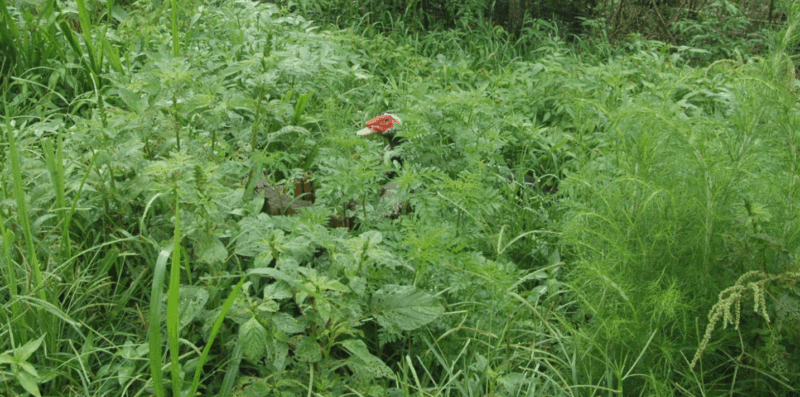
Muscovy ducks are an exception to all these sex identifiers because they are not related to mallard ducks. Male Muscovies don’t get drake feathers.
Instead, they get noticeably larger in size than the females just a few days after birth. They also develop more pronounced caruncles around their face and neck than their female counterparts once they feather and as they age.
Both male and female Muscovy ducks lose their voices and make whispering sounds and vibrate the air to communicate.
Duck Breeding
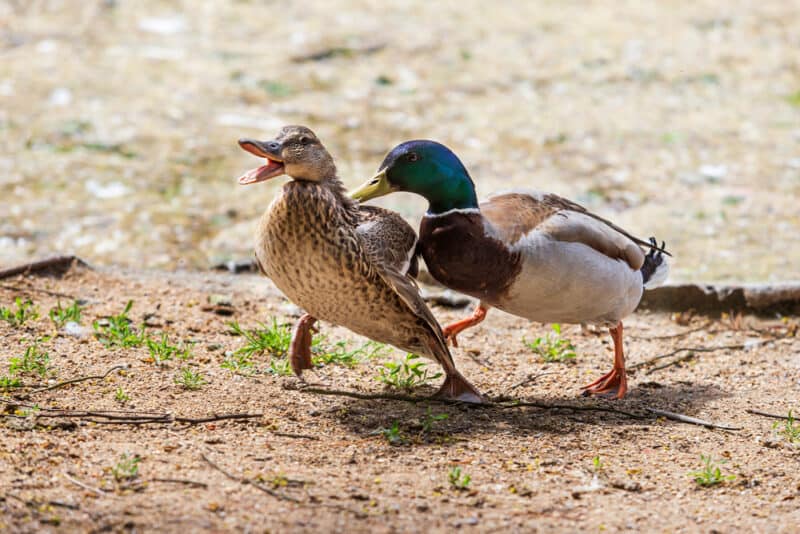
Unlike chicken sex which is over in seconds, male and female ducks require stimulation to do the deed. The female will normally lie on her belly on the ground or allow herself to be mounted in the water.
The male will mount the female and make sweeping motions with his tale area. If you watch carefully, you’ll notice fluid coming from the female vent during this action.
It can take a few minutes for the male to become stimulated. However, when it happens, his corkscrew penis projects quickly into the female duck’s vent. Then, the act is over in just a few seconds.
The female usually gets up and leaves or swims off. The male stays put until his penis retracts. During that post-coital minute or two, he is a sitting duck and subject to easy predation.
Males are naturally competitive when it comes to mating. So, if you have multiple males in proximity to a submissive female, they may all try to mount her simultaneously. This can, as you’d imagine, be stressful for the females.
Quick Tip: Breeding
Don’t keep more drakes than you need. If your ducks breed on large pasture or ponds, 1 drake per 5 females results in good fertilization of eggs. If you breed your ducks in confinement, then 1 drake can service 10 female ducks with good fertilization rates.
Hatching Ducks
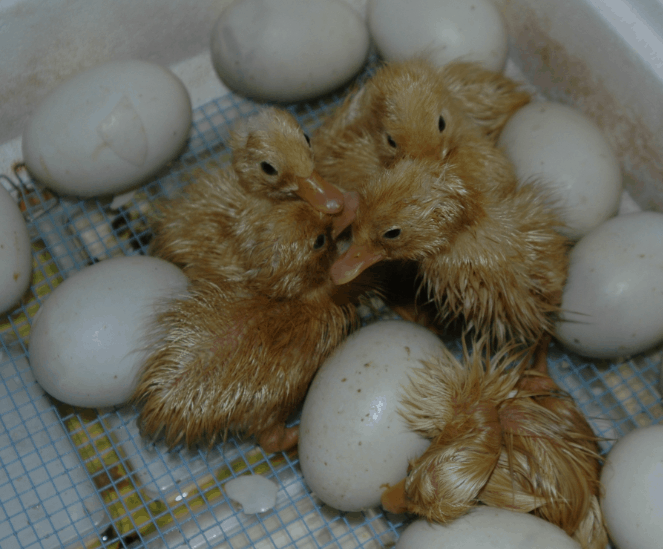
Once you have fertilized eggs, the next step is to hatch them. You can either use a broody duck to set a nest and hatch your eggs or you can use an incubator and hatch them yourself.
Either way, it takes 28 days of you or a duck tending and turning those eggs to hatch most duck breeds. Muscovy duck eggs take 35 days to hatch. Some other non-domesticated ducks also take over a month to hatch.
Incubating duck eggs is more challenging than chicken eggs. However, with the right equipment and an understanding of humidity and the development cycle of the embryo, you can get good results at home.
Day Old Ducklings
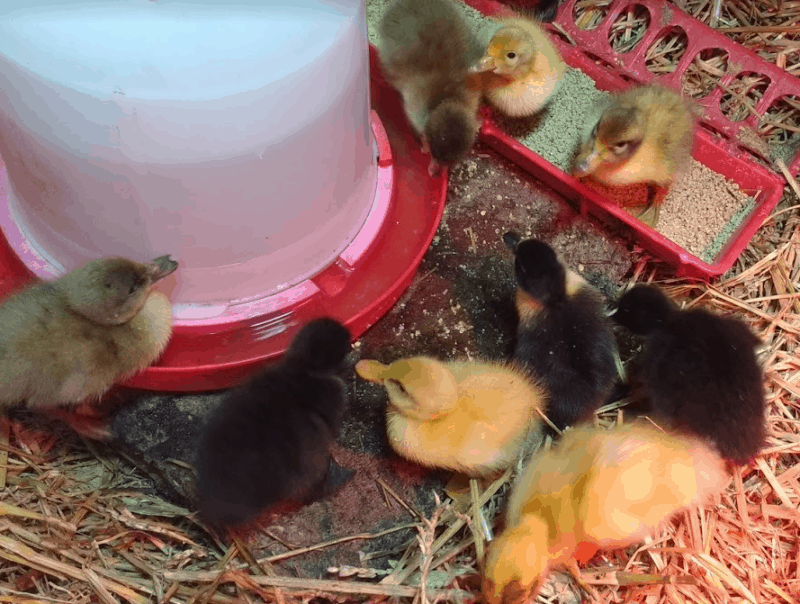
The more common way to get started with ducks, though, is to order day-old ducklings from hatcheries. Ducklings are shipped together in a vented box, usually with pre-moistened food in the center of the box.
1. Quick Ship
Ducklings have a shorter window to start eating than baby chicks. So, if at all possible, choose a hatchery that can ship to you in under 2 days of travel.
Also, contact your post office to let them know your ducklings are coming by mail. Then be ready to pick your ducklings up the moment they arrive at your post office.
2. Feed and Water ASAP
As soon as you get your ducklings home, it’s critical to make sure they immediately begin eating and drinking. Dunk each ducklings bill in the water, then dip it in the food.
Place those food and water containers right next to each other so ducklings have easy access. Later you’ll want to put your food further away from the water, so it doesn’t get wet. However, for the first 24 hours until you can tell that your ducklings are growing bigger, keep them next to each other.
Raising Ducklings
Whether you hatch your own or have them delivered in a box, those little ducklings will need some help to reach maturity. Namely, they need appropriate food, access to water, and a safe, predator-free place to grow.
Duckling Food
Duckling food can be hard to find. So, if you want to use mixed flock, game bird, or adapt chicken formulas for ducks, then you’ll want to read our detailed guide on duck protein requirements to make sure you get the right protein mix during duckling development.
You can also use one of these methods to ensure proper duck nutrition without doing extra research.
1. Order Duck Starter
You can find duck starter online or order it at farm stores. It’s expensive, but it has the complete nutrition ducklings need including extra niacin and ideal protein sources.
Also, it should come with exact instructions for how much and how long to feed ducklings each formulation to avoid potential nutrition-related health complications.
2. Chick Feed + Niacin
Ducklings can also eat chick starter as long as it has enough niacin. Formulations that have at least 55 ppm of niacin listed on the bag, or 55 mg per kg, are fine to feed to ducks as is. If this information isn’t listed, then add supplemental niacin to chick feed to ensure it is safe for ducklings for at least the first 10 weeks.
To supplement niacin, I use three 500 mg human-grade niacin vitamin tablets per 50-pound bag of feed. I powder them with a mortar and pestle. Then I sprinkle the equivalent of about 1/50th of the powdered amount in each pound of feed.
This works out to about 68 mg of niacin per kg of feed. Chicks require niacin too, so there should also be some niacin already in your chick start. Still, this quantity is safe for ducklings in my experience. It also gives me a safe cushion given that I am doing a bit of guesswork on my sprinkle method.
Note: If your farm supply store only sells medicated chick starter, then please read our post on medicated chick starter for ducks to decide if that feed will work for your ducklings.
3. Brewer’s Yeast
Some people also use brewer’s yeast as a niacin supplement for ducks. Niacin quantities in brewer’s yeast vary by product. You’ll need to read the label and calculate how much to apply to your feed.
Also be aware that since you need to add large quantities of brewer’s yeast to get sufficient total niacin for ducklings, it can dilute or increase some of the other nutrient quantities such as total protein content of your duck feed program.
4. Nitty Gritty Feed Details
Ducklings that only eat crumbled starter feed don’t need grit. However, if you plan to give your ducks other treats, like greens or mealworms, make sure to give them access to chick-sized grit. Or give them access to pasture areas that contain grit in the soil.
Grit gets stored in a duck’s crop and is used to help pulverize larger food particles before it reaches the stomach where it is digested. Think of grit as the blade of a food processor while the crop is both the barrel and the motor.
Access to Water
Healthy ducklings are ready to swim within a few hours after hatching. However, because they don’t have feathers and are new to swimming, they are subject to hypothermia and drowning with prolonged water exposure.
Ducklings should only be allowed access to swim when supervised and for a few minutes at a time. Also, the water source should be easy to get in and out to prevent drowning. Finally, swimming should only be allowed when its warm or if a heat source is provided so ducklings can dry quickly.
Quick Tip: Swimming

You can either wait a few weeks until ducks are larger and begin to develop some fat stores before allowing them to swim. Or give them supervised visits to a beginner pond such as a paint pan that has a defined shallow end and deep end.
Access to Drinking Water
Whether you let duckling swim or not, they’ll always need access to plenty of drinking water. Also, their drinking water container should be deep enough that they can dunk their entire bills in it so they can clear debris or food bits that make block their nostrils occasionally.
Inevitably, they’ll try to turn their drinking water into a swimming hole. So, that makes watering ducklings difficult.
Chicken waterers set on bricks so they can’t be tipped over are a good option. Shallow containers with rims also work well for just a few ducklings.
Be prepared to refill those containers often despite your best attempts to keep ducks from making ponds from their drinking water.
Duckling Protection
Ducklings are born with incredible natural instincts to avoid predators. Recently, I watched with amazement as some barely 2-day old ducklings swam under, around, and hid silently in brushy areas to avoid a 40-pound dog relentlessly pursuing them.
Their ingenious escape tactics were such a testament to how incredibly prepared little ducklings are for their free-range life. Ultimately though, the dog would have won because he had more stamina than those tiny ducklings. (So, I had to adopt them).
However, this tale tells you what you need to think about related to duck safety. Ducklings are born prepared to navigate complex environments and aren’t as prone to accidents as chicks or turkey poults. Yet, they still need 100% predator protection if you want to grow them to maturity.
Quick Start: Duckling Brooder
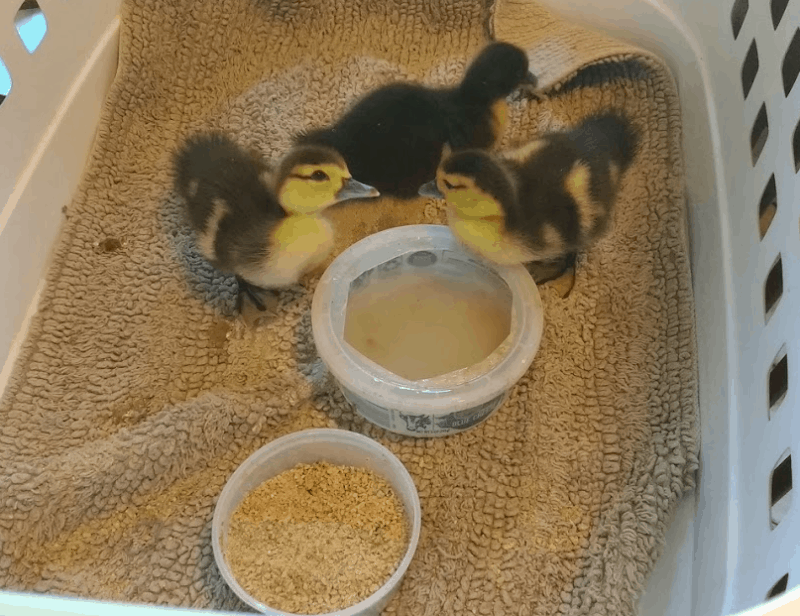
This is why raising ducklings in brooders or fully protected runs with shelters is key. All sorts of brooder spaces will work. However, for your convenience, keep these things in mind when designing your duckling areas.
- Give yourself access so you can easily reach your ducklings
- Choose a design that is easy to clean
- Make sure your duckling area is 100% predator proof for things as small as a small rat, as large as a dog, and secure from overhead predators like hawks or owls
- Space should be a minimum of 10 times larger than your duck, e.g. a 2-inch duck needs 20-inches of space, and a 1-foot duck needs 10-feet of space.
What About Heat?
I’ll probably ruffle a few feathers by saying this. Still, I only give ducklings heat if I raise them in cold weather or in chilly, uninsulated outbuildings.
1. No Heat Method
When I raise them in my house, or after the weather becomes consistently warm in late spring and summer, I just give them deep litter and a cozy place to cuddle up with their flock mates. I do this by setting a straw-lined pet carrier in their brooder area.
I’ve done experiments where I offered ducklings heat on one side and the carrier on the other and they always opted for the carrier even in cold temperatures. So, I raise ducklings in warm weather and skip the risk of fire on the homestead from heat lamps or ceramic heaters.
2. Hatchery Heat Method
Hatcheries, however, recommend that you give ducklings heat similar to chickens. Put a lamp or other heat source in your brooder area. Start with brooder temperatures around 95-98°F. Then, lower the temperature in the brooder by 5 to 10° per week.
Turn it off during the day in week 2 or 3. Remove heat entirely by weeks 3-5, or when ducks no longer seem to need the heat.
Friendly Ducklings
Making ducklings enjoy being petted and held is much more challenging than with chickens. However, if you stick to it daily during their first 10 formative weeks, they will love it as much as your cats or dogs do.
Secure their feet when holding them up. Massage their crop area to keep them calm. Also, dress appropriately, projectile poop is normal when handling young ducklings.
Duck Predators
Ducks are still highly preyed upon as most of them cannot fly, and they go to their housing later at night than chickens. Dogs are also a threat to ducks unless they have been specifically trained not to kill ducks.
With cats, you cannot train cats not to hunt birds and although they won’t chase a duck that is bigger than them, ducklings are an easy target.
The list of common duck predators is long and even includes rats as they are terrible duckling predators too. Here are a few other predators with links to articles helping you get rid of them:
Keeping ducks fenced is one option to protect them from most predators, however, they need secure nighttime protection, plus daytime protection and supervision. Ideally, a large deep pond would allow them to escape to the water when threatened, or a wild-like terrain could be useful to help them evade predators.
A fence only makes them trapped and more of a target, as you will have predators that can dig underneath or others than can fly in. Make sure you use hard material for flooring and dig the fence down deep as a means of discouraging digging predators.
With hawks, some say that hawks need ample space to pull a victim up and away, as they can’t fly up and down vertically like a helicopter. However, in my experience, even a narrow space with a tall fence is not sufficient as I have seen a hawk fly in and kill a duck right there and proceeded to eat it.
A better deterrent for hawks is lots of obstacles making it difficult for them to fly in and out, or again, a deep pond where ducks can dive in and hide, with loads of vegetation around the pond to hide as well.
For more information on this, read our guide about poultry predators.
Duck Shelter
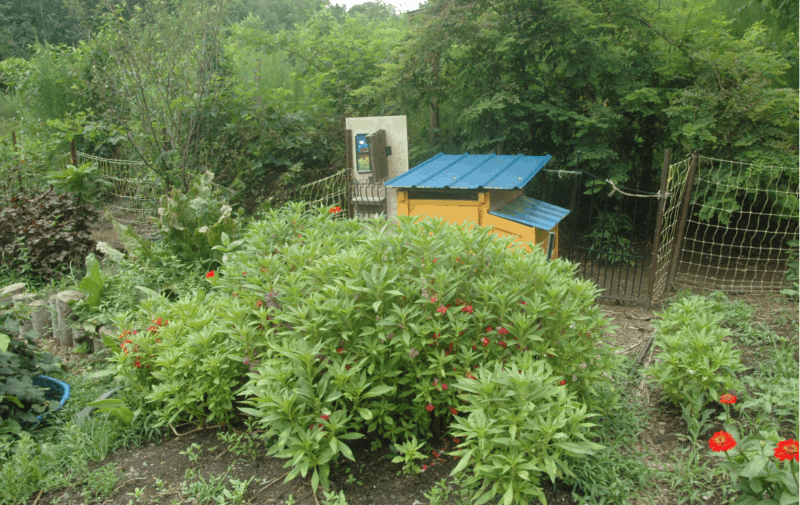
Ducklings typically only need to stay in a brooder for about 3-6 weeks depending on breed and your weather conditions. Then they are ready to transition to their adult duck space.
There are lots of ways to house juvenile and adult ducks. Some people even keep ducks with chickens.
If you want to try DIY-ing a duck coop, read up on further duck coop considerations before selecting one of these free duck house plans.
Also, here are some of my recommendations based on several years of experimenting with duck housing and runs.
Layer Ducks
Layer ducks are a long-term commitment. Since it will take 5-8 months before they start to lay and they can keep laying for years, you want to ensure total safety for your layers.
1. Large Runs/Small Shelters
For layers, I recommend fully secure large duck runs made with wire mesh or hardware cloth. Rather than large coops like for chickens, I am now transitioning to using small duck houses set inside the large runs to protect dry ground nests. Ducks really seem to like cozy, low-ceilinged shelters for sleeping and laying.
Also, I’ve discovered that keeping my duck houses small enough that I can simply pick them up and move them to a new spot in the run is much easier than cleaning inside a coop-like duck shelter. If you only have a few laying ducks, dog houses are easy to find ready-made options that work great in a fully secured run.
After you move the shelter, rake up poopy litter and compost it. Or heavily seed the area with a fast-growing cover crop and fresh straw to let nature do the clean-up for you.
2. Nesting Areas

Also, note, domesticated ducks are ground nesters by nature. Ducks can be trained to nest in raised nest boxes like chickens. However, you’ll get a higher number of eggs laid randomly in ponds or in the middle of the run using nest boxes.
Instead, offer appropriate ground nesting areas filled with natural litter such as hay, straw, leaves, or pine needles.
3. Feeding Layers
Feeding layer ducks is quite a bit easier than feeding young, juvenile, or meat ducks. They will do fine on chicken layer feed with 16% protein. Or you can formulate your own duck feed from a variety of different grains, seeds, and other nutritious items.
You can also grow plants specifically for your ducks. Duckweed and water hyacinth grown as fodder are particularly wonderful supplements for confined ducks.
For best health, you’ll also want to give your ducks insect protein, such as mealworms. Also, daily access to some green pasture or deliveries of lots of weeds and leafy greens keeps ducks healthy long-term.
Meat Ducks

Meat ducks have short lives. You also tend to raise more of them at one time.
So, it’s not always possible or necessary to keep meat ducks in large formal runs with permanent housing. However, they still need protection from predators.
Giving ducks totally secure nighttime shelters and semi-protected daytime pastures work well in areas with limited predator pressure. Using electric fences or livestock guardian dogs can also help. Some people also raise meat ducks inside moveable hardware cloth covered cattle panel hoop houses.
Always make sure your meat ducks have adequate protection from sun and heat. Meat breeds grow fast and tend to overheat easily once temperatures get above 80°F.
Grooming
Ducks groom in water. At the minimum, you want to give each of your ducks 2-gallons of water per day in a bucket or small pool so they can drink and use to maintain their feathers and keep cool.
Ideally though, to keep your ducks happy, you should fill a small kiddie pool or mini-pond for them daily. You can then use the dirty water from that pond to water the soil around your perennial plants.
Dabbling Ducks
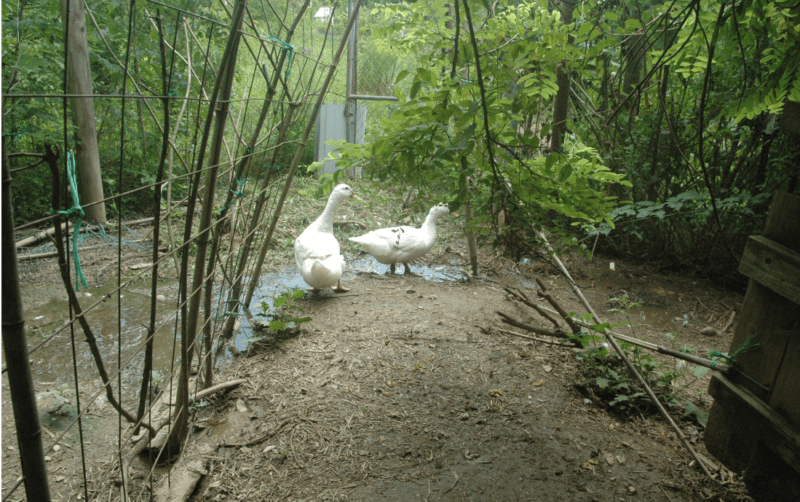
Another thing to know about domesticated ducks is they are dabblers. Dabbling ducks like to feed on the shallow edges or muddy areas around ponds and in puddles. Sometimes you’ll see them dunk their entire head to get deeper while their bottom stays afloat like a buoy.
Because this is a natural and necessary duck behavior, if you don’t offer them a place to dabble, they will create one. For example, they will add soil or food to their water to mimic the muddy, boggy areas they know to be excellent sources of protein from insect larva and frogs.
Accept Dirty Water
Trying to keep duck water clean spoils all your ducks’ hard work to create suitable dabbling areas for themselves. Instead, give your ducks fresh water daily. However, don’t try to stop them from making it dabbler-friendly.
Also, your ducks will splash water all over the ground every chance they get as another way to create areas to dabble in. Plan the runoff from your water buckets or duck pools to be directed to places that can absorb some extra water.
Mud Zone

Or better yet, just give them a dedicated mud zone for dabbling in. It won’t be pretty. Even so, you can plant lots of things around the outside of your duck run to obscure their muddy messes.
With smart planning, the runoff from your mud zone could also be directed so that it waters and fertilizes those planting areas and saves you work.
Molting Ducks
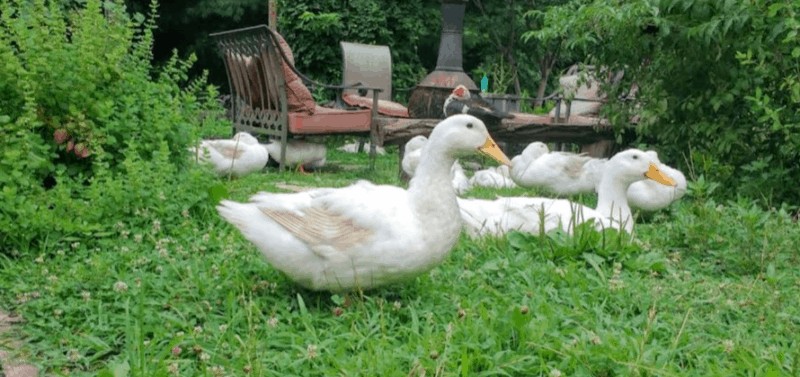
Another thing you need to know about for your laying, pet, or breeding ducks is that they will molt. Unlike chickens, duck molting patterns aren’t as clearly defined and vary by climate and breed.
Ducks also don’t molt all at once as chickens do. Instead, they lose and replace various areas of feathers at different times of the year. Generally, though, over the course of a year, most duck breeds will fully replace all their feathers at one point or another.
Muscovy ducks may not fully molt each year. They will renew their downy feathers annually but the replacement of wing, contour, and head feathers is much more random than with other duck breeds.
Duck Problems
There are a few duck problems to be aware of.
1. Bumblefoot
Occasionally ducks can get bumblefoot like chickens. I have yet to see it despite the crazy terrain my ducks walk all over regularly. Still, I have read that it happens.
2. Angel Wing
Angel wing is a wing distortion that can happen when you feed ducklings the wrong kinds of carbohydrates and proteins while their wing feathers are first developing. It is also entirely avoidable by feeding ducklings the right feed for their stage of development.
3. Eye Infections
Ducks that aren’t allowed to groom in fresh water are more prone to eye infections. Make sure to give your ducks plenty of fresh water for good hygiene.
4. Mycotoxins
It should go without saying but giving ducks moldy food is a definite no. Moldy foods often contain mycotoxins that can cause a host of digestive and fertility issues in ducks. It can also lead to lesions and immune system failures.
Keep your feed in dry locations. Don’t let wet moldy food linger in your duck areas. Check all feed for mold before offering it to ducks.
5. Other Serious Diseases
Like all animals, there are also some other serious diseases that can befall ducks. Although you aren’t likely to encounter them as a homestead duck keeper, you’ll want to be ready with good tools to use to research duck diseases just in case.
Further Learning

Now that you know the basics of keeping ducks, you might also want to explore all the various ways, e.g. duckquaponics, to put them to use on your homestead.
Not every option will be right for every environment, but with some research and experimentation, you can find great ways to harvest duck manure, use them for pest management, and enhance your pleasure in homesteading with ducks.
Ducks are an absolute joy to raise, keep, and benefit from as long as you take the time to understand their needs, support their health with good choices, and keep them safe from predation or unnecessary risks.
